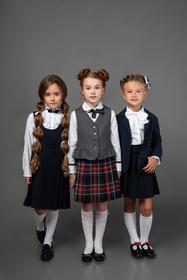For the 2025-26 school year, there are 2 public middle schools serving 397 students in Goodland School District. This district's average middle testing ranking is 2/10, which is in the bottom 50% of public middle schools in Kansas.
Public Middle Schools in Goodland School District have an average math proficiency score of 17% (versus the Kansas public middle school average of 26%), and reading proficiency score of 14% (versus the 28% statewide average).
Minority enrollment is 28% of the student body (majority Hispanic), which is less than the Kansas public middle school average of 35% (majority Hispanic).
Overview
This School District
This State (KS)
# Schools
4 Schools
444 Schools
# Students
910 Students
135,097 Students
# Teachers
60 Teachers
9,658 Teachers
Student-Teacher Ratio
15:1
15:1
Student By Grade
District Rank
Goodland School District, which is ranked within the bottom 50% of all 286 school districts in Kansas (based off of combined math and reading proficiency testing data) for the 2022-2023 school year.
The school district's graduation rate of 72% has decreased from 90-94% over five school years.
Overall District Rank
#249 out of 286 school districts
(Bottom 50%)
(Bottom 50%)
Math Test Scores (% Proficient)
23%
31%
Reading/Language Arts Test Scores (% Proficient)
23%
32%
Science Test Scores (% Proficient)
30-34%
31%
Graduation Rate
72%
89%
Students by Ethnicity:
Diversity Score
0.43
0.54
% American Indian
n/a
1%
% Asian
1%
2%
% Hispanic
23%
20%
% Black
1%
6%
% White
72%
65%
% Hawaiian
n/a
n/a
% Two or more races
3%
6%
All Ethnic Groups
District Revenue and Spending
The revenue/student of $15,254 in this school district is less than the state median of $16,284. The school district revenue/student has stayed relatively flat over four school years.
The school district's spending/student of $14,384 is less than the state median of $17,200. The school district spending/student has stayed relatively flat over four school years.
Total Revenue
$14 MM
$7,774 MM
Spending
$13 MM
$8,211 MM
Revenue / Student
$15,254
$16,284
Spending / Student
$14,384
$17,200
Best Goodland School District Public Middle Schools (2025-26)
School
(Math and Reading Proficiency)
(Math and Reading Proficiency)
Location
Quick Facts
Rank: #11.
Goodland Jr-sr. High School
(Math: 15-19% | Reading: 14%)
Rank:
Rank:
2/
Bottom 50%10
1209 Cherry
Goodland, KS 67735
(785) 890-5656
Goodland, KS 67735
(785) 890-5656
Gr: 7-12 | 394 students Student-teacher ratio: 14:1 Minority enrollment: 28%
Recent Articles

Public School Open House & Enrollment Season Guide
A parent-focused guide to the public school open house and enrollment season, with expert questions, timelines, and decision tips.

School Supply Budget 2026: Fees, Books, Tech Costs
School Supply Budget 2026 guide for parents, covering fees, textbooks, technology, and hidden extras to plan ahead.

Education Funding in America (2025 Update)
Comprehensive 2025 update on public school funding in America, new federal and state policies, per-pupil spending, and equity challenges.





